Dear Editor,
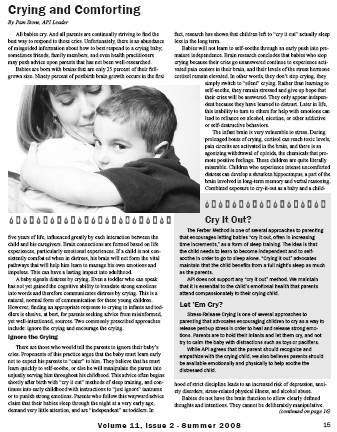 The article “Crying and Comforting” from The Journal of API, Summer 2008 AP in a Non-AP World issue, states: “Two commonly prescribed approaches include: ignore the crying and encourage the crying,” and it offers API’s stance on responding to our crying babies by saying, “Fortunately for parents and babies alike, there is a warm and compassionate middle ground between ignoring and encouraging crying. The AP approach…involves recognizing and empathizing with a baby’s emotions and patiently working with him to uncover the unmet need causing the tears.”
The article “Crying and Comforting” from The Journal of API, Summer 2008 AP in a Non-AP World issue, states: “Two commonly prescribed approaches include: ignore the crying and encourage the crying,” and it offers API’s stance on responding to our crying babies by saying, “Fortunately for parents and babies alike, there is a warm and compassionate middle ground between ignoring and encouraging crying. The AP approach…involves recognizing and empathizing with a baby’s emotions and patiently working with him to uncover the unmet need causing the tears.”
I would like to offer the perspective that there are various gentle approaches for comforting a crying baby, each of which is unique – as unique as every loving and attuned mother-child relationship.
It is common for mothers who are highly attuned to their babies to know when their babies simply need to cry – and when they are crying because of an unmet need. A mother might use additional soothing behaviors for her in-arms baby, or she might not. She might continue to search for causes for the crying, or perhaps not. If she feels like bouncing her crying baby, then she does. If she feels like holding her baby in stillness, then she will. When she opens her heart and follows her baby’s cues, she knows best what to do.
About the prevalence of approaches that encourages crying: I could not find any advice on the internet that promotes the encouragement of crying in babies and children. In my experience talking with many parents, I have not known anyone who encourages their babies and children to cry. Is this truly a commonly prescribed and followed approach?
Those parents I know who have learned about the stress-release crying approach do not decide to encourage their babies to cry. Rather, they interpret the approach as saying that it’s important not to discourage their babies from crying.
To illustrate this interpretation, I’ll share a friend’s story: Her two-year-old daughter was in an accident and was seriously burned. Weeks after the accident, her daughter sometimes needed to “cry and release her fears and tensions of what she had been through.” My friend explained that when her daughter didn’t want the breast, “I’d hold her but not attempt to stop her [from crying]. Some small thing would have her in floods of tears, and I could just tell that it wasn’t about the small thing, but about the accident.”
The Benefits of In-Arms Comforting of Crying Babies
I was confused about the following statements made about the stress-release crying approach in the Journal article:
- “The parent is unable to identify the need using her mental checklist, so she holds the baby without comforting behaviors;” and
- “Parents are to hold their infants and let them cry, and not try to calm the baby with distractions such as toys or pacifiers. While API agrees that the parent should recognize and empathize with the crying child, we also believe parents should be available emotionally and physically to help soothe the distressed child.”
Tender holding of one’s crying baby is itself one of the most soothing, comforting maternal behaviors available to any mothers. Mother can stand, sit, or lie down with baby in her arms. The simple act of holding one’s baby includes movement, sounds, smells, and touch, as well as other comforting sensations and feelings that defy description. Baby experiences the warmth of mother’s arms and body; soothing, rhythmic bodily sounds, such as mother’s breathing and heartbeat; comforting, rhythmic movements, like the rise and fall of mother’s chest and the whoosh of air from mother’s lungs as she exhales, and the rise and fall of his own chest against hers; the familiar smells of her body; and the comforting awareness that his mother – the source of all things good and wonderful – is there with him.
A message of unconditional love is offered, and received. Baby may sometimes be able to focus better on all of these most basic comforts, some of which are reminders of the womb environment, when mother holds him in stillness and silence, without rocking, bouncing, jiggling, rocking, singing, humming, etc.
I’m guessing most mothers would not want to restrict themselves from using any key comforting behaviors along with holding. Moreover, we would want to use them in any combination that feels “right” to us in the moment. For me, that might sometimes mean holding my baby without the use of other comforting behaviors and sometimes without endeavouring to find causes for the crying. I would not want to restrict myself from simply holding my baby, because sometimes it was exactly what my baby and I needed. This still holds true for my children (now 6 and 4) and me.
The tender holding of one’s baby or young child without other comforting behaviors does not need to be associated only with the stress-release crying approach. For me, to discard the option to hold my crying baby in stillness is to throw my baby out with his tears.
Are We Generally Accepting or Unaccepting of Crying?
There are at least two powerful influences that may be – but do not need to be – affecting our responses to our babies’ crying: Our upbringing and our culture. It may be helpful for parents to be mindful of these influences and start shifting their perspective, if necessary:
- If we were raised by parents who let us cry-it-out alone as babies and/or who discouraged our crying, then quite possibly our own reactions to our babies’ crying are exaggerated by our own unresolved childhood hurts. How did my parents handle my crying? What feelings are aroused in me by my baby’s crying?
- Crying is a behavior that is not embraced and accepted much in our society. What messages am I hearing about crying from doctors, friends, family, television, books, etc.? How much am I influenced by societal views about crying?
If a parent tends to be unaccepting of crying, she may lean towards either extreme of ignoring, or actively discouraging, her baby’s crying. I wonder, though, if it is common for parents to express their lack of acceptance in more subtle ways?
It seems to me that there is a fine line between discouraging crying and using soothing responses while searching for causes for the crying. How does my baby or child interpret my continuing efforts to search out reasons for his crying? Does he continue to sense my unconditional love for him? And what is the impact on me?
If a solution-focused mother is unable to pacify her baby, his crying may increase, which in turn may cause the mother to intensify her search for a solution. If she still isn’t able to discover the unmet need, she may understandably start becoming anxious (and mothers’ anxiety is often exacerbated when they are sleep deprived). The baby senses his mother’s growing anxiety and may become more distressed. It can become a vicious spiral.
Mother has lost touch with the moment. She isn’t paying attention to her baby’s evolving cues. Desirous of a settled baby (which isn’t the baby she has in her arms!), she may forget just how much she loves the one who is crying in her arms. She may forget to listen to him. To really listen to him. With stress levels rising, she might end up either blaming her baby or herself: “There is something wrong with my baby because he continues to cry. He’s not a good baby.” Or, “There is something wrong with me. I am failing my child because I can’t stop his crying. I’m a bad mother.” Of course, no one is to blame.
I would like to take a closer look at the toe-and-sock example given in the article: “Imagine that a baby is trying to communicate, ‘The seam on my sock is irritating my toe.’ The parent is unable to identify the need using her mental checklist, so she holds the baby without comforting behaviors.” The situation described sounds to me like a type of unobvious irritation that would likely go undiscovered by many mothers, no matter how they view their baby’s crying, whether or not they use soothing behaviors in addition to holding and whether or not they continue searching for solutions. So, in this type of situation, is it possible that the parent might find herself in a vicious spiral as she strives to find out what is causing the crying?
I also wonder whether it might be possible for any additional soothing behaviors, such as rocking, swinging, jiggling, and bouncing, to aggravate the irritation of baby’s toe? Furthermore, the parent might be in solution-oriented mode and eventually happen to take off the sock that is irritating baby’s toe, but perhaps her intuition might more readily lead her to do that when she has not been jiggling, rocking, singing to the baby, and not in search of reasons for the crying?
About the stress-release crying approach, the article states: “If the close contact alone is not enough to soothe the child…there will be further release of potentially damaging cortisol in the child’s brain and there will be no release of calming opioids. The child’s emotions may spiral out of control, leading to feelings of anger and rage and potentially toxic brain chemistry.” In light of the advice: “The AP approach…involves recognizing and empathizing with a baby’s emotions and patiently working with him to uncover the unmet need causing the tears,” I feel concerned about the impact of this statement on mothers, especially those new to mothering, and worry that this information punctuates the overall message about the importance of being solution-oriented.
The Benefits of Acceptance
It seems to me that a gentle approach to crying need not always be solution-oriented. In our busy, solution-driven society, we are admonished – or admonish ourselves – “Don’t just stand there. Do something!” Sometimes, especially in stressful situations, I find it helpful to remind myself of Buddha’s words, “Don’t do something. Just stand there!” Don’t do. Be. Be present. Be mindful. Be centered in my love for myself and my baby.
In order to provide calm and loving support to my crying in-arms baby, I found (and still find) it helpful to center myself in peaceful acceptance of the situation; to be still in my body, mind, and spirit; and not jump instantly into fix-it mode. However, that’s not always easy to do, especially when I’m tired, and given my tendency to be unaccepting of crying! So, I give myself the following reminders:
- Focus on my breathing: Breathe slowly and deeply.
- Bathe my thoughts in the gratitude I feel for the simplest of things: Being alive, having arms and hands to hold, touch and feel, eyes to see, ears to hear. Celebrating these most basic pleasures gives me strength to deal with the challenges of this moment.
- Connect with my love for myself and my child. I love my child so much. I love myself.
- Answers will arrive to me when I flow with the situation, rather than resist it.
- I am being the loving parent I wish to be.
- My in-arms child knows that I love him just as he is now, tears and all. He knows my love for him is unconditional.
- My child senses my inner peace, and this positive energy is soothing to him.
- My child will not continue to cry forever. He will stop crying.
When I was attuned to my baby’s state, I was (as any attuned mother is) able to distinguish whether he was meeting a need by crying or his crying was a request for help in meeting a need. If, for instance, he wanted to breastfeed, I knew his signals and responded accordingly by offering my breast. However, on occasion I was not able to figure out what the need was. And, as far as I’m concerned, that was OK! I’m not a perfect mother! In my imperfect moments, holding my baby close to my heart, and just breathing deeply, eyes closed, was sometimes exactly what he – and I – needed.
With the conscious intention to remain present and highly attuned to my children, and aware of how my upbringing and culture influence me, I simply wish to respond lovingly to my child’s feelings and needs, be mindful and accepting of what each moment brings, and not be too anxious to bounce or sing away my child’s every tear.
~ Tamara Parnay, The Netherlands
RESPONSE
Thank you, Tamara, for your letter. API’s intention in publishing the article was to warn parents against advice regarding comforting baby’s cries that works against the parent-child bond. API agrees with you that comforting the crying should be focused on meeting the need of the child. If a baby is comforted by being held still, that would certainly be more responsive and sensitive than to try rocking or jiggling.
The caution is against refusing to soothe a child who could be soothed by noises, repetitive motion, etc. because this particular child would cry longer and harder without these soothing techniques and that this is supposed to be a good thing for the child. API does not agree with this stance on encouraging crying.
There is a difference between soothing during an emotional outpouring and trying to stifle the crying. A parent can encourage a complete release of emotion while also comforting and soothing, and if the child prefers not to be soothed, then this is the better choice for the parents to make in order to respond sensitively.
Lastly, as you pointed out, it is important that the parent stays calm while soothing and comforting, even when unable to determine the cause of the crying. The important point is that the parent continues to seek ways to soothe the child, rather than giving up.
Thanks again for your letter, as it helps API to clarify our stance and helps to answer similar questions from other AP parents.
~ Rita Brhel, editor of The Journal of API
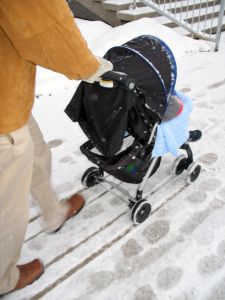 A study conducted at Dundee University in London suggests that babies transported in forward-facing buggies are more likely to suffer emotional stress due to lack of face-to-face time with their parents.
A study conducted at Dundee University in London suggests that babies transported in forward-facing buggies are more likely to suffer emotional stress due to lack of face-to-face time with their parents.
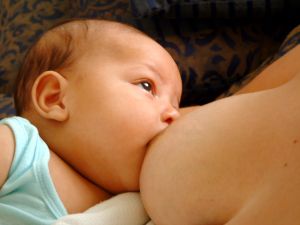


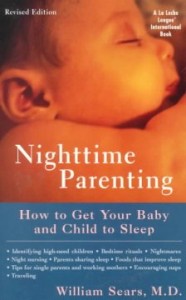

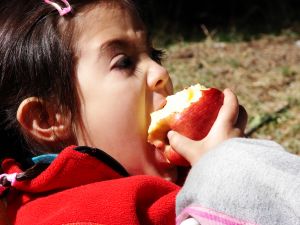 At two years old, my son Ezra was a happy child, who seems to handle the frustrations of becoming socialized and civilized with amazing ease. If things got to be too much for him, he sought out momentary comfort at his mother’s breast, his tears were dried, tantrums were avoided, and hurts were healed.
At two years old, my son Ezra was a happy child, who seems to handle the frustrations of becoming socialized and civilized with amazing ease. If things got to be too much for him, he sought out momentary comfort at his mother’s breast, his tears were dried, tantrums were avoided, and hurts were healed.
 The article “Crying and Comforting” from The Journal of API, Summer 2008 AP in a Non-AP World issue, states: “Two commonly prescribed approaches include: ignore the crying and encourage the crying,” and it offers API’s stance on responding to our crying babies by saying, “Fortunately for parents and babies alike, there is a warm and compassionate middle ground between ignoring and encouraging crying. The AP approach…involves recognizing and empathizing with a baby’s emotions and patiently working with him to uncover the unmet need causing the tears.”
The article “Crying and Comforting” from The Journal of API, Summer 2008 AP in a Non-AP World issue, states: “Two commonly prescribed approaches include: ignore the crying and encourage the crying,” and it offers API’s stance on responding to our crying babies by saying, “Fortunately for parents and babies alike, there is a warm and compassionate middle ground between ignoring and encouraging crying. The AP approach…involves recognizing and empathizing with a baby’s emotions and patiently working with him to uncover the unmet need causing the tears.”